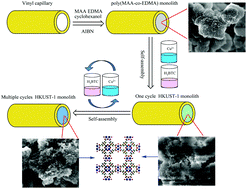In situ synthesis of metal–organic frameworks in a porous polymer monolith as the stationary phase for capillary liquid chromatography†
Abstract
In this study, HKUST-1 was synthesized in situ on the porous polymer monolith as the stationary phase for capillary liquid chromatography (cLC). The unique carboxyl functionalized poly(methacrylic acid-co-ethylene dimethacrylate) (poly(MAA-co-EDMA)) monolith was used as a support to directly grow HKUST-1 by a controlled layer-by-layer self-assembly strategy. X-ray diffraction, scanning electron microscopy, energy dispersive X-ray spectrometry, and Fourier transform infrared spectroscopy of the resulting HKUST-1-poly(MAA-co-EDMA) monoliths indicated that HKUST-1 was successfully grafted onto the pore surface of the poly(MAA-co-EDMA) monolith. The column performance of HKUST-1-poly(MAA-co-EDMA) monoliths for the separation of various small molecules, such as benzenediols, xylenes, ethylbenzenes, and styrenes, was evaluated. The chromatographic performance was found to improve with increasing HKUST-1 density, and the column efficiencies and resolutions of HKUST-1-poly(MAA-co-EDMA) monoliths were 18 320–19 890 plates m−1 and 1.62–6.42, respectively, for benzenediols. The HKUST-1-poly(MAA-co-EDMA) monolith displayed enhanced resolution for the separation of positional isomers when compared to the traditional C18 and HKUST-1 incorporated polymer monoliths. Hydrophobic, π–π, and hydrogen bonding interactions within the HKUST-1-poly(MAA-co-EDMA) monolith were observed in the separation of small molecules. The results showed that the HKUST-1-poly(MAA-co-EDMA) monoliths are promising stationary phases for cLC.


 Please wait while we load your content...
Please wait while we load your content...